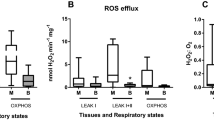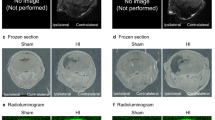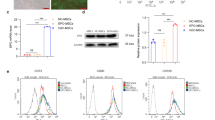Abstract
The mechanism of neuroprotection associated with systemically administered magnesium remains unclear. This investigation examined the acute effects of systemically administered MgSO4 on brain extracellular ([Mg]ecf) and intracellular ([Mg]i) fluid Mg concentrations, specific brain phosphorylated metabolites, and brain intracellular pH. Miniswine were studied with P-31 magnetic resonance spectra, to derive [Mg]i, and brain microdialysis probes, to measure [Mg]ecf. Animals were infused with MgSO4 (n = 5, 275 mg/kg over 30 min followed by 100 mg/kg over 30 min, designated MgHI) or Na2SO4 (n = 5, designated NaHI), and both groups underwent hypoxia-ischemia (HI) over the last 15 min of the infusions. Groups differed in plasma [Mg] at the completion of HI (9.1 ± 1.5 versus 1.1 ± 0.6 mM for MgHI and NaHI, respectively, p < 0.05). MgHI had elevations of [Mg]ecf (0.23 ± 0.11 and 0.40 ± 0.14 mM at control and completion of HI, respectively), and [Mg]ecf was unchanged for NaHI (p < 0.05 versus MgHI). At the completion of HI, MgHI had greater decreases in nucleoside triphosphate (NTP) (48 ± 6% of control), and more brain acidosis after HI (6.01 ± 0.07) compared with NaHI (NTP, 70 ± 3% of control; brain pH, 6.51 ± 0.14, both p < 0.05 versus MgHI). [Mg]i increased to elevated values during HI in both MgHI and NaHI (p < 0.05 versus control of each group) and remained higher in MgHI over the next 25 min (p < 0.05 versus NaHI). There were inverse correlations during HI between [Mg]i and brain NTP (r2 = 0.73 and 0.59 for MgHI and NaHI, respectively), and brain acidosis (r2 = 0.85 and 0.85 for MgHI and NaHI, respectively) in each group. These findings indicate complex effects of Mg on the brain. Elevation of [Mg]ecf may be beneficial with regards to excitatory neurotransmitters. However, greater disturbance of brain NTP concentration, more acidosis, and the increase in [Mg]i may offset any benefit. The results warrant further investigation using indicators of neuronal injury to determine whether Mg supplementation provides neuroprotection.
Similar content being viewed by others
Log in or create a free account to read this content
Gain free access to this article, as well as selected content from this journal and more on nature.com
or
Abbreviations
- HI:
-
hypoxia-ischemia
- HR:
-
heart rate
- MAP:
-
mean arterial pressure
- [Mg]plasma:
-
plasma Mg concentration
- [Mg]ecf:
-
extracellular fluid Mg concentration
- [Mg]i:
-
intracellular fluid Mg concentration
- NTP:
-
nucleoside triphosphate
- 31P NMR:
-
phosphorus 31 nuclear magnetic resonance
- PCr:
-
phosphocreatine
- pHi:
-
intracellular pH
- Pi:
-
inorganic phosphate
References
Nowak L, Bregestovski P, Ascher P, Herbet A, Prochiantz A 1984 Magnesium gates glutamate-activated channels in mouse central neurons. Nature 307: 462–465
Lipton SA, Rosenberg PA 1994 Excitatory amino acids as a final common pathway for neurologic disorders. N Engl J Med 330: 613–622
Hagberg H, Lehmann A, Sandberg M, Nystrom B, Jacobson I, Hamberger A 1985 Ischemia-induced shift of inhibitory and excitatory amino acids from intra- to extracellular compartments. J Cereb Blood Flow Metab 5: 413–419
Rasch DK, Huber P, Richardson CJ, L'Hommedieu CS, Nelson TE, Reddi R 1982 Neurobehavioral effects of neonatal hypermagnesemia. J Pediatr 100: 272–276
Stone SR, Pritchard JA 1970 Effect of maternally administered magnesium sulfate on the neonate. Obstet Gynecol 35: 574–577
Green KW, Key TC, Coen R, Resnik R 1983 The effects of maternally administered magnesium sulfate on the neonate. Am J Obstet Gynecol 146: 29–33
Cunningham FG, MacDonald PC, Grant NF 1989 Hypertensive disorders in pregnancy. In: Cunningham FG, MacDonald PC, Gant NF (eds) Williams Obstetrics, 18th Ed. Appleton and Lange, Norwalk, CT, pp 653–694.
Hallak M, Cotton DB 1993 Transfer of maternally administered magnesium sulfate into the fetal compartment of the rat: assessment of amniotic fluid, blood, and brain concentrations. J Obstet Gynecol 169: 427–431
Gee JB, Corbett RJT, Perlman JM, Garcia D, Laptook AR 1999 Age-dependent differences in the relationship between plasma and brain extracellular fluid concentrations of magnesium after MgSO4 infusions in miniswine. Pediatr Res 46: 281–286
Iseri LT, French JH 1984 Magnesium: nature's physiologic calcium blocker. Am Heart J 108: 188–193
LeBlanc MH, Farias LA, Markov AK, Evans OB, Smith B, Smith EE, Brown EG 1991 Fructose-1,6-diphosphate, when given five minutes after injury, does not ameliorate hypoxic ischemic injury to the central nervous system in the newborn pig. Biol Neonate 59: 98–108
Corbett RJT, Laptook AR, Garcia D, Ruley JI 1993 Energy reserves and utilization rates in developing brain measured in vivo by 31P and 1H nuclear magnetic resonance spectroscopy. J Cereb Blood Flow Metab 13: 235–246
Corbett RJT, Gee J, Laptook AR 1996 Calculation of intracellular cerebral [Mg2+] during hypoxic ischemia by in vivo31P NMR. Neuroreport 8: 287–291
Corbett RJT, Laptook AR, Nunnally RL 1987 The use of the chemical shift of the phosphomonoester P-31 magnetic resonance peak for the determination of intracellular pH in the brains of neonates. Neurology 37: 1771–1779
Corbett RJT, Laptook AR, Ruley JI, Garcia D 1991 The effect of age on glucose modulated cerebral agonal glycolytic rates measured in-vivo by 1H NMR spectroscopy. Pediatr Res 30: 579–586
Corbett R, Laptook A, Kim B, Tollefsbol G, Silmon S, Garcia D 1999 Maturational changes in cerebral lactate and acid clearance following ischemia measured in vivo using magnetic resonance spectroscopy and microdialysis. Brain Res Dev Brain Res 113: 37–46
Laptook AR, Peterson J, Porter AM 1987 Cerebral lactic acid delivery and uptake during and after ischemia in the piglet. Neurology 37: 1549–1552
Rivera LI, Gootman PM, Brust M, Condemi G, Hundley BH, Lin RH, Cohen HL, Gandhi MR, Altura BT, Gootman N 1990 Unusual observations on hypermagnesemic levels and cardiorespiratory effects in neonatal swine. Magnes Trace Elem 9: 124–131
Caspi J, Coles JG, Benson LN, Herman SL, Augustine J, Wilson GJ 1994 Dose related effects of magnesium on myocardial function in the neonate. Hypertension 23: 174–178
James MFM, Cork RC, Dennett JE 1987 Cardiovascular effects of magnesium sulphate in the baboon. Magnesium 6: 314–324
Kim C-R, Oh W, Stonestreet BS 1997 Magnesium is a cerebrovasodilator in newborn piglets. Am J Physiol 272: H511–H516
Günzel D, Schlue W-R 1996 Sodium-magnesium antiport in Retzius neurones of the leech Hirudo medicinalis. J Physiol 491: 595–608
Kato H, Gotoh H, Kajikawa M, Suto K 1998 Depolarization triggers intracellular magnesium surge in cultured dorsal root ganglion neurons. Brain Res 779: 329–333
Helpern JA, Vande Linde AM, Welch KM, Levine SR, Schultz LR, Ordidge RJ, Halvorson HR, Hugg JW 1993 Acute elevation and recovery of intracellular [Mg2+] following human focal cerebral ischemia. Neurology 43: 1577–1581
Brooks KJ, Bachelard HS 1989 Changes in intracellular free magnesium during hypoglycaemia and hypoxia in cerebral tissue as calculated from 31P-nuclear magnetic resonance spectra. J Neurochem 53: 331–334
Romani A, Scarpa A 1992 Regulation of cell magnesium. Arch Biochem Biophys 298: 1–12
Gotoh H, Kajikawa M, Kato H, Suto K 1999 Intracellular Mg2+ surge follows Ca2+ increase during depolarization in cultured neurons. Brain Res 828: 163–168
Touyz RM, Schiffrin EL 1996 Angiotensin II and vasopressin modulate intracellular free magnesium in vascular smooth muscle cells through Na+-dependent protein kinase C pathways. J Biol Chem 271: 24353–24358
Sebille S, Millot JM, Maizieres M, Arnaud M, Delabroise AM, Jacquot J, Manfait M 1996 Spatial and temporal Mg2+ signaling in single human tracheal gland cells. Biochem Biophys Res Commun 227: 743–749
Gaeda M, Singh J, Domschke W, Mooren F Ch, Wisdom DM 1996 Secretagogue-evoked mobilization of magnesium in mouse pancreatic acini. J Physiol 493: 90–91
Brocarad JB, Rajdev S, Reynolds IJ 1993 Glutamate-induced increases in intracellular free Mg2+ in cultured cortical neurons. Neuron 11: 751–757
Stout AK, Li-Smerin Y, Johnson JW, Reynolds IJ 1995 Mechanisms of glutamate-stimulated Mg2+ influx and subsequent Mg2+ efflux in rat forebrain neurons in culture. J Physiol 492: 41–657
Andiné P, Sandberg M, Bågenholm R, Lehmann A, Hagberg H 1991 Intra- and extracellular changes of amino acids in the cerebral cortex of the neonatal rat during hypoxic-ischemia. Dev Brain Res 64: 115–120
Vink R, McIntosh TK, Demediuk P, Weiner M, Faden AI 1988 Decline in intracellular free Mg2+ is associated with irreversible tissue injury after brain trauma. J Biol Chem 263: 757–761
Bareyre FM, Saatman KE, Helfaer MA, Sinson G, Weisser JD, Brown AL, McIntosh TK 1999 Alterations in ionized and total blood magnesium after experimental traumatic brain injury: relationship to neurobehavioral outcome and neuroprotective efficacy of magnesium chloride. J Neurochem 73: 271–280
Regan RF, Jasper E, Guo Y, Panter SS 1998 The effect of magnesium on oxidative neuronal injury in vitro. J Neurochem 70: 77–85
Blumberg RM, Cady BE, Wigglesworth JS, McKenzie JE, Edwards AD 1997 Relation between delayed impairment of cerebral energy metabolism and infarction following transient focal hypoxia-ischaemia in the developing brain. Exp Brain Res 113: 130–137
McDonald JW, Silverstein FS, Johnston MV 1990 Magnesium reduces N-methyl-D-aspartate (NMDA)-mediated brain injury in perinatal rats. Neurosci Lett 109: 234–238
Wolf G, Keilhoff G, Fischer S, Hass P 1990 Subcutaneously applied magnesium protects reliably against quinolinate-induced N-methyl-D-aspartate (NMDA)-mediated neurodegeneration and convulsions in rats: are there therapeutical implications?. Neurosci Lett 117: 207–211
McIntosh TK, Vink R, Yamakami I, Faden AI 1989 Magnesium protects against neurological deficit after brain injury. Brain Res 482: 252–260
Izumi Y, Roussel S, Pinard E, Seylaz J 1991 Reduction of infarct volume by magnesium after middle cerebral artery occlusion in rats. J Cereb Blood Flow Metab 11: 1025–1030
Thordstein M, Bågenholm R, Thiringer K, Kjellmer I 1993 Scavengers of free oxygen radicals in combination with magnesium ameliorate perinatal hypoxic-ischemic brain damage in the rat. Pediatr Res 34: 23–26
Tsuda T, Kogure K, Nishioka K, Watanabe T 1991 Mg2+ administered up to twenty-four hours following reperfusion prevents ischemic damage of the CA1 neurons in the rat hippocampus. Neuroscience 44: 335–341
Penrice J, Amess PN, Punwani S, Wylezinska M, Tyszczuk L, D'Souza P, Edwards AD, Cady EB, Wyatt JS, Reynolds EO 1997 Magnesium sulfate after transient hypoxia-ischemia fails to prevent delayed cerebral energy failure in the newborn piglet. Pediatr Res 41: 443–447
de Haan HH, Gunn AJ, Williams CE, Heymann MA, Gluckman PD 1997 Magnesium sulfate therapy during asphyxia in near-term fetal lambs does not compromise the fetus but does not reduce cerebral injury. Am J Obstet Gynecol 176: 18–27
Nelson KB, Grether JK 1995 Can magnesium sulfate reduce the risk of cerebral palsy in very low birthweight infants?. Pediatrics 95: 263–269
Schendel DE, Berg CJ, Yeargin-Allsop M, Boyle CA, Decoufle P 1996 Prenatal magnesium sulfate exposure and the risk for cerebral palsy or mental retardation among very low-birth-weight children aged 3 to 5 years. JAMA 276: 1805–1810
Leviton A, Paneth N, Susser M, Reuss ML, Allred EN, Kuban K, Sanocka U, Hegyi T, Hiatt M, Shahrivar F, Van Marter LJ 1997 Maternal receipt of magnesium sulfate does not seem to reduce the risk of neonatal white matter damage. Pediatrics 99: E2
Acknowledgements
The authors thank William Gitomer, Ph.D., and the staff of the Mineral and Metabolism Laboratory at Parkland Hospital, Dallas, TX.
Author information
Authors and Affiliations
Corresponding author
Additional information
Supported, in part, by a grant from the Wyeth Pediatrics Neonatology Research Fund.
Rights and permissions
About this article
Cite this article
Gee, J., Corbett, R., Perlman, J. et al. The Effects of Systemic Magnesium Sulfate Infusion on Brain Magnesium Concentrations and Energy State During Hypoxia-Ischemia in Newborn Miniswine. Pediatr Res 55, 93–100 (2004). https://doi.org/10.1203/01.PDR.0000099771.39629.E5
Received:
Accepted:
Issue date:
DOI: https://doi.org/10.1203/01.PDR.0000099771.39629.E5



